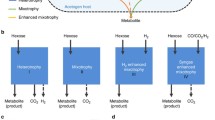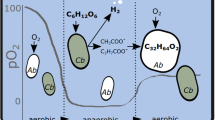Abstract
The ethanol-oxidizing, proton-reducing Pelobacter acetylenicus was grown in chemostat cocultures with either Acetobacterium woodii, Methanobacterium bryantii, or Desulfovibrio desulfuricans. Ymax and me were determined from the total molar growth yields determined at growth (dilution) rates between 0.02 and 0.14 h-1. The individual growth yields of the partner organisms were determined from their numbers and cellular mass in the chemostat cocultures. The Gibbs free energy (ΔG=-16.3 kJ/mol ethanol) available to P. acetylenicus as well as its Ymax (1.7–2.2 g/mol ethanol) were almost constant in the different cocultures. P. acetylenicus shared 44–67% of the total biomass produced, whereas it shared only 19, 23, and 37% of the total Gibbs free energy (ΔG) available from ethanol oxidation coupled to sulfate reduction, methanogenesis, and homoacetogenesis, respectively. The residual 63–81% of the total available ΔG were shared by the H2 oxidizers which exhibited Ymax values being highest for A. woodii (6.6 g/mol acetate) > D. desulfuricans (3.8 g/mol sulfide) > M. bryantii (2.2 g/mol CH4). The results are discussed with respect to ATP generation and coupling of catabolism with cell production.
Similar content being viewed by others
References
Badziong W, Thauer RK (1978) Growth yields and growth rates of Desulfovibrio vulgaris (Marburg) growing on hydrogen plus sulfate and hydrogen plus thiosulfate as the sole energy source. Arch Microbiol 117:209–214
Cypionka H, Pfennig N (1986) Growth yields of Desulfotomaculum orientis with hydrogen in chemostat culture. Arch Microbiol 143:396–399
Fardeau ML, Belaich JP (1986) Energetics of the growth of Methanococcus thermolithotrophicus. Arch Microbiol 144: 381–385
Lynd LH, Zeikus JG (1983) Metabolism of H2−CO2, methanol, and glucose by Butyribacterium methylotrophicum. J Bacteriol 153:1415–1423
Morrii H, Koga Y, Nagai S (1987) Energetic analysis of the growth of Methanobrevibacter arboriphilus A2 in hydrogen-limited continuous cultures. Biotechnol Bioeng 29:310–315
Nethe-Jaenchen R, Thauer RK (1984) Growth yields and saturation constant of Desulfovibrio vulgaris in chemostat culture. Arch Microbiol 137:236–240
Pirt SJ (1965) The maintenance energy of bacteria in growing cultures. Proc R Soc 163 B:224–231
Roberton AM, Wolfe RS (1970) Adenosine triphosphate in Methanobacterium. J Bacteriol 102:43–51
Schink B (1984) Fermentation of 2,3-butanediol by Pelobacter carbinolicus sp.nov. and Pelobacter propionicus sp. nov., and evidence for propionate formation from C2 compounds. Arch Microbiol 137:33–41
Schink B (1985) Fermentation of acetylene by an obligate anaerobe, Pelobacter acetylenicus sp. nov. Arch Microbiol 142:295–301
Schink B (1990) Conservation of small amounts of energy in fermenting bacteria. In: Finn RK, Präve P (eds) Biotechnology focus 2. Hanser, München, pp 63–89
Schink B (1991) Syntrophism among prokaryotes. In: Balows A, Trüper HG, Dworkin M, Harder W, Schleifer KH (eds) The prokaryotes, 2nd edn. Springer, Berlin Heidelberg New York
Schönheit P, Moll J, Thauer RK (1980) Growth parameters (Ks, μmax, Ys) of Methanobacterium thermoautotrophicum. Arch Microbiol 127:59–65
Seitz HJ, Cypionka H (1986) Chemolithotrophic growth of Desulfovibrio desulfuricans with hydrogen coupled to ammonification of nitrate or nitrite. Arch Microbiol 146:63–67
Seitz HJ, Schink B, Pfennig N, Conrad R (1990a) Energetics of syntrophic ethanol oxidation in defined chemostat cocultures. 1. Energy requirement for H2 production and H2 oxidation. Arch Microbiol 155:82–88
Seitz HJ, Sineriz F, Schink B, Conrad R (1990b) Hydrogen production during fermentation of acetion and acetylene by Pelobacter acetylenicus. FEMS Microbiol Lett 71:83–88
Stouthamer AG (1979) The search for correlation between theoretical and experimental growth yields. In: Quayle JR (ed) International review on biochemistry, microbiol biochemistry, vol 21, University Park Press, Baltimore, pp 1–47
Thauer RK, Morris JG (1984) Metabolism of chemotrophic anaerobes: old views and new aspects. Symp Soc Gen Microbiol 36:123–168
Thauer RK, Jungermann K, Decker K (1977) Energy conservation in chemotrophic anaerobic bacteria. Bacteriol Rev 41:100–180
Van Dam K, Mulder MM, De Mattos JT, Westerhoff HV (1988) A thermodynamic view of bacterial growth. In: Bazin MJ, Prosser JI (eds) Physiological modesl in microbiology, vol 1. CRC Press, Boca Raton, Florida, pp 25–48
Westerhoff HV, Lolkema JS, Otto R, Hellingwerf KJ (1982) Thermodynamics of growth. Non-equilibrium thermodynamics of bacterial growth. The phenomenological and the mosaic approach. Biochim Biophys Acta 683:181–220
Author information
Authors and Affiliations
Rights and permissions
About this article
Cite this article
Seitz, H.J., Schink, B., Pfennig, N. et al. Energetics of syntrophic ethanol oxidation in defined chemostat cocultures. Arch. Microbiol. 155, 89–93 (1990). https://doi.org/10.1007/BF00291280
Received:
Accepted:
Issue Date:
DOI: https://doi.org/10.1007/BF00291280




